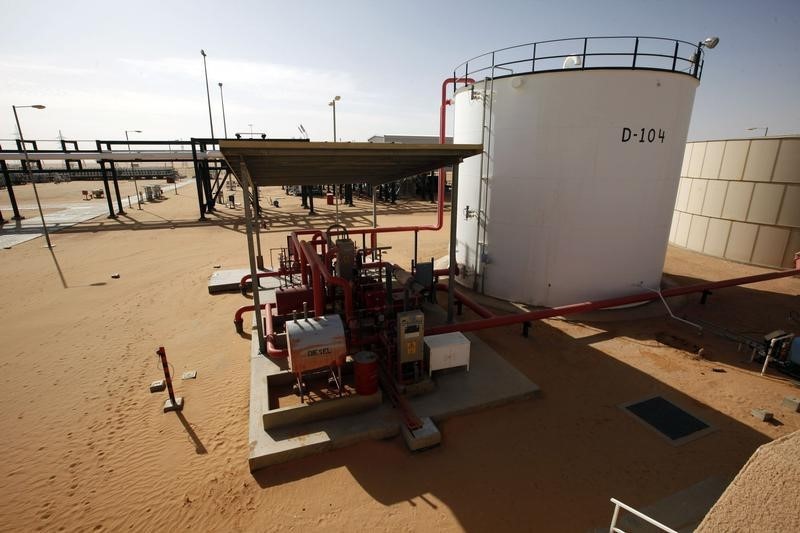(In Sept 8 item, corrects paragraph 3 to clarify number refers
to barrels per day, not number of wells)
By Nia Williams
LLOYDMINSTER, Canada, Sept 8 (Reuters) - Amid the corn and
canola fields of western Saskatchewan, oil foreman Dwayne Roy is
doing what Saudi Arabia and fellow OPEC producers are loath to
do: shutting the taps on active wells.
Inside a six-foot-square wooden shed that houses a basic
hydraulic pump, the Gear Energy Ltd GXE.TO employee
demonstrates how shutting down a conventional heavy oil well in
this lesser-known Canadian oil patch is as simple as flipping a
switch. His company has already done so multiple times this
year, making the Lloydminster industry among the first in the
world to yield in a global battle for oil market share that has
sent crude prices tumbling to six-year lows.
Gear Energy Ltd GXE.TO , has idled up to 500 barrels per
day of production from its least efficient wells this year, many
of them in the past weeks. Some cost of up to C$28 ($21.22) a
barrel to operate. It costs another C$7 in royalty and
transportation fees to get the crude, among the densest in the
world, to regional rail hubs - where it was fetching barely $20
a barrel during last month's lows.
"We ask every day: is this well making money today? Will it
make us money going forward?" says Roy.
Such questions have been nagging oil industry veterans since
crude prices started sliding last year as a result of a supply
glut caused by a battle between exporters' group OPEC and North
American shale oil producers.
Energy firms around the world have responded by laying off
thousands of workers and slashing spending by billions of
dollars. But producers here are the first to do what the global
market needs to rebalance: turn off the taps.
All told, at least 8,000 barrels per day (bpd) of local
heavy conventional oil production has been idled by firms such
as Gear, Canadian Natural Resources Ltd CNQ.TO and Baytex
Energy Corp BTE.TO this year.
So far their actions are merely symbolic - the output loss
represents less than a rounding error in a global market that
produces 95 million barrels each day.
Yet if prices stay low, other firms such as Husky Energy
HSE.TO and Devon Energy (NYSE:DVN) DVN.N could also shut in similar
wells that produce conventional heavy crude, which accounts for
roughly 11 percent of Canada's 3.7 million bpd output.
Some producers in the North Sea are also starting to shut
older fields earlier than planned, and thousands of small U.S.
"stripper well" operators may follow suit. urn:newsml:reuters.com:*:nL8N0ZQ2M8
"Heavy oils are some of the most flexible capital and can
easily be dialled back up or ramped back up again if we choose,"
CNRL chief executive Steve Laut told analysts last month.
CNRL has shut in about 4,000 bpd of high cost heavy oil
production.
NEW "SWINGERS"
After the Organization of the Petroleum Exporting Countries
said a year ago that it would no longer curb its own production
to make way for fast-growing rivals, many analysts and traders
have looked to the burgeoning U.S. shale industry to take over
the role as the "swing" producers, responding to prices by
cranking up or dialling down drilling within months.
Canadian conventional heavy crude producers are even
nimbler.
Around Lloydminster, a city of about 32,000 that straddles
Alberta and Saskatchewan provinces, jet-black production tanks
dot the rolling prairie.
Each pair of tanks serves a single well, and each well can
be shut down - or restarted - with ease.
"For us it's honestly a matter of flicking a switch," says
Ingram Gillmore, chief executive of Gear Energy, which produces
5,500 bpd in the region. "I can bring production back into an
improved pricing environment in a matter of days."
To shut down a well, an operator will rent a "flushby" truck
with a derrick and winch for a couple of hours to pump a
lubricating fluid down the well to help prevent any build up of
sand. After that, all one needs is to kill the pump motor, latch
the shed door and wait for oil prices to recover.
By contrast, most of the world's big oil producers will keep
pumping even during a slump to keep cash coming because of the
high upfront capital expenditures and the time and cost needed
to shut down and restart complex, big scale operations.
Robert Bedin, an analyst at ITG Investment Research
estimates that it can cost hundreds of thousands of dollars to
shut down - and later restart - oil sands behemoths some 350
miles (572 kilometres) to the northeast.
According to some estimates, when U.S. crude CLc1 tanked
below $40 a barrel and Canadian heavy crude fell below $20 last
month, nearly all the country's oil sands and conventional heavy
production was operating in the red. ID:nL1N10V2KB
While most shut-in wells will get restarted if prices
recover, some older ones may be gone for good.
At one such dismantled well site a pile of dented steel
panels, metal piping, some wooden beams and a couple of concrete
blocks lie next to the abandoned wellhead.
Eventually Gear will pull out the wellhead, cement the well,
level the clay and spread topsoil so grass can grow again. And
then it will start over here or in a different spot as soon as
prices allow.
